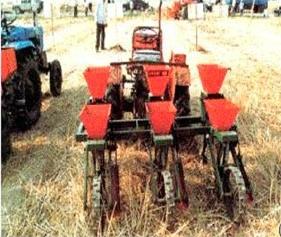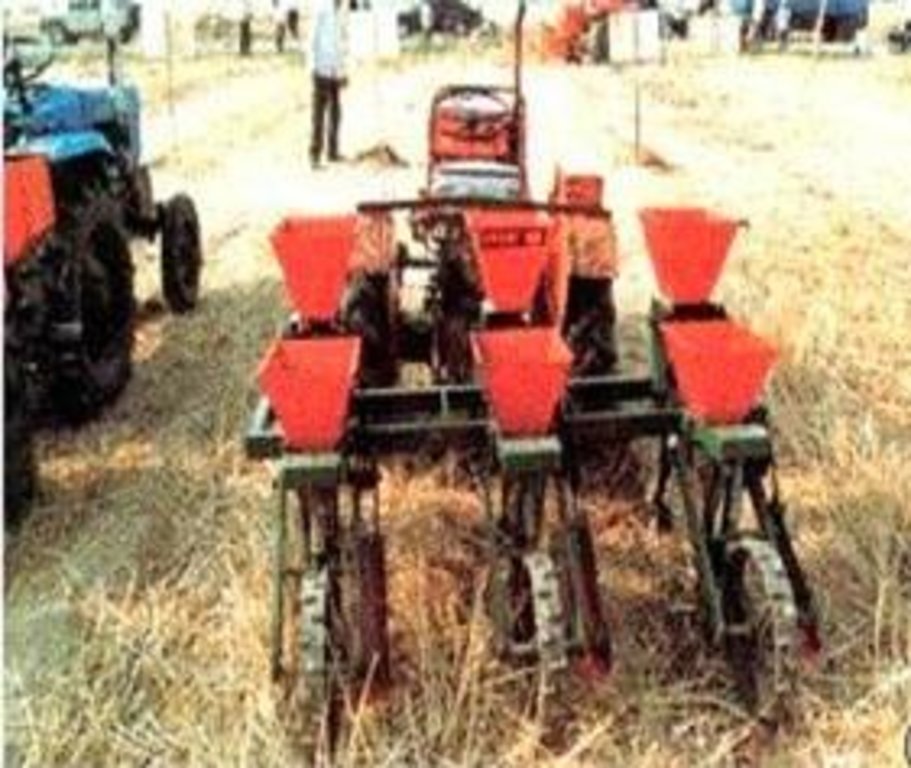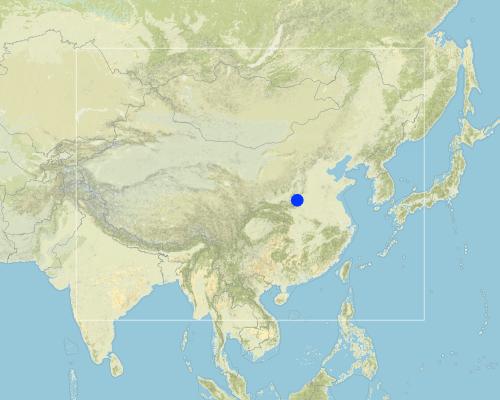Zero Tillage [China]
- Creation:
- Update:
- Compiler: Zhanguo Bai
- Editor: –
- Reviewers: David Streiff, Alexandra Gavilano
No Tillage
technologies_969 - China
View sections
Expand all Collapse all1. General information
1.2 Contact details of resource persons and institutions involved in the assessment and documentation of the Technology
Name of the institution(s) which facilitated the documentation/ evaluation of the Technology (if relevant)
ISRIC World Soil Information (ISRIC World Soil Information) - Netherlands1.3 Conditions regarding the use of data documented through WOCAT
When were the data compiled (in the field)?
17/05/2002
The compiler and key resource person(s) accept the conditions regarding the use of data documented through WOCAT:
Ja
1.5 Reference to Questionnaire(s) on SLM Approaches

Zero Tillage [China]
Zero tillage approach was developed to protect the soils from sealing rainfall, to achieve and maintain a open internal soil structure, to enhance biological processes in the soil, and to develop a means for safe disposal of any surface runoff that nevertheless will occur.
- Compiler: Zhanguo Bai
2. Description of the SLM Technology
2.1 Short description of the Technology
Definition of the Technology:
Zero tillage technology was developed to protect the soils from sealing rainfall, to achieve and maintain a open internal soil structure, to enhance biological processes in the soil, and to develop a means for safe disposal of any surface runoff that nevertheless will occur.
2.2 Detailed description of the Technology
Description:
No tillage with residual mulching is developed to minimally disturb soil structure, directly to sow in the residual mulching covered soils. The crop system is rotated. It is used to maintain the soil moisture and particles that would be moved by runoff and improve soil fertility.
2.3 Photos of the Technology
2.5 Country/ region/ locations where the Technology has been applied and which are covered by this assessment
Country:
China
Region/ State/ Province:
Henan province
Map
×2.6 Date of implementation
If precise year is not known, indicate approximate date:
- less than 10 years ago (recently)
2.7 Introduction of the Technology
Specify how the Technology was introduced:
- through projects/ external interventions
Comments (type of project, etc.):
USA, Canada
3. Classification of the SLM Technology
3.2 Current land use type(s) where the Technology is applied

Cropland
- Annual cropping
Comments:
Major land use problems (compiler’s opinion): Traditional till farming (multi-till system) has made soil loose and easily being moved on the dry and semi-dry slope farmland. No coverage exist after harvest and till leading to serious erosion. Meanwhile less and less organic fertilizer is applied and replaced by increase in chemical fertilizer use so that soil fertility and crop quality decline.
Major land use problems (land users’ perception): More and more input are needed to maintain stable yield, quality of the crops and fruits are declining.
Type of cropping system and major crops comments: After harvest of wheat in June, corn or peanut or bean are saw and harvest in later autumn
3.3 Further information about land use
Water supply for the land on which the Technology is applied:
- rainfed
Comments:
Water supply: rainfed, mixed rainfed - irrigated
Number of growing seasons per year:
- 1
Specify:
Longest growing period in days: 180Longest growing period from month to month: Apr - SepSecond longest growing period in days: 90Second longest growing period from month to month: Jun - Sep
3.4 SLM group to which the Technology belongs
- minimal soil disturbance
3.5 Spread of the Technology
Specify the spread of the Technology:
- evenly spread over an area
If the Technology is evenly spread over an area, indicate approximate area covered:
- 100-1,000 km2
Comments:
Total area covered by the SLM Technology is 800 m2.
This technique has been successfully applied in the slope farmland, especially in the Loess Plateau and in the dry-semidry regions in the NW China. It is an ideal approach to infiltrate all precipitation in soils and reduce soil erosion and water loss in slope farmland.
3.6 SLM measures comprising the Technology

agronomic measures
- A3: Soil surface treatment
Comments:
Main measures: agronomic measures
Type of agronomic measures: mulching, zero tillage / no-till
3.7 Main types of land degradation addressed by the Technology

soil erosion by water
- Wt: loss of topsoil/ surface erosion
- Wg: gully erosion/ gullying

soil erosion by wind
- Et: loss of topsoil

chemical soil deterioration
- Cn: fertility decline and reduced organic matter content (not caused by erosion)

water degradation
- Ha: aridification
Comments:
Main type of degradation addressed: Wt: loss of topsoil / surface erosion, Wg: gully erosion / gullying, Ha: aridification
Secondary types of degradation addressed: Et: loss of topsoil, Cn: fertility decline and reduced organic matter content
Main causes of degradation: other human induced causes (specify) (agricultural causes - irrational tillage on the slopeland), land tenure (Land subdivision)
Secondary causes of degradation: other natural causes (avalanches, volcanic eruptions, mud flows, highly susceptible natural resources, extreme topography, etc.) specify (insufficient rainfall and not well distribution), Lack of enforcement of legislat./authority
3.8 Prevention, reduction, or restoration of land degradation
Specify the goal of the Technology with regard to land degradation:
- prevent land degradation
4. Technical specifications, implementation activities, inputs, and costs
4.2 Technical specifications/ explanations of technical drawing
Technical knowledge required for field staff / advisors: moderate
Technical knowledge required for land users: moderate
Main technical functions: control of dispersed runoff: retain / trap, control of dispersed runoff: impede / retard, improvement of ground cover, increase in organic matter, increase of infiltration, water harvesting / increase water supply, water spreading, sediment retention / trapping, sediment harvesting, reduction in wind speed, improvement of soil structure, increase in soil fertility
Secondary technical functions: increase / maintain water stored in soil
Mulching
Material/ species: film
Quantity/ density: 60% of sur
Remarks: alignment
Agronomic measure: residual cover
Material/ species: residual, straw
Quantity/ density: 80% of sur
Remarks: mean
Zero tillage / no-till
Remarks: Leaving residual after havest
4.3 General information regarding the calculation of inputs and costs
Specify currency used for cost calculations:
- US Dollars
Indicate average wage cost of hired labour per day:
5.00
4.5 Costs and inputs needed for establishment
Comments:
Duration of establishment phase: 96 month(s)
4.6 Maintenance/ recurrent activities
| Activity | Type of measure | Timing/ frequency | |
|---|---|---|---|
| 1. | applying fertilizer | Agronomic | after harvest / each cropping season |
| 2. | Sowing using no-till machine | Agronomic | after harvest / each cropping season |
| 3. | weeding | Agronomic | crop growing / each cropping season |
4.7 Costs and inputs needed for maintenance/ recurrent activities (per year)
Comments:
Machinery/ tools: No-till machine, tractor
Subsidy is needed at the beginning of the SWC implementation.
4.8 Most important factors affecting the costs
Describe the most determinate factors affecting the costs:
Zero tillage machine and tractor
5. Natural and human environment
5.1 Climate
Annual rainfall
- < 250 mm
- 251-500 mm
- 501-750 mm
- 751-1,000 mm
- 1,001-1,500 mm
- 1,501-2,000 mm
- 2,001-3,000 mm
- 3,001-4,000 mm
- > 4,000 mm
Specifications/ comments on rainfall:
646mm for Luoyang/Henan
Agro-climatic zone
- semi-arid
- arid
5.2 Topography
Slopes on average:
- flat (0-2%)
- gentle (3-5%)
- moderate (6-10%)
- rolling (11-15%)
- hilly (16-30%)
- steep (31-60%)
- very steep (>60%)
Landforms:
- plateau/plains
- ridges
- mountain slopes
- hill slopes
- footslopes
- valley floors
Altitudinal zone:
- 0-100 m a.s.l.
- 101-500 m a.s.l.
- 501-1,000 m a.s.l.
- 1,001-1,500 m a.s.l.
- 1,501-2,000 m a.s.l.
- 2,001-2,500 m a.s.l.
- 2,501-3,000 m a.s.l.
- 3,001-4,000 m a.s.l.
- > 4,000 m a.s.l.
Indicate if the Technology is specifically applied in:
- not relevant
Comments and further specifications on topography:
Hill slopes: SE part of the Loess Plateau, mainly hilly area
Plateau / plains: low proportion in the whole SWC applied area
Valley floors: small area in the whole SWC applied area but output high with better irrigation systems
Slopes moderate: There is not much terraces built in this area and slope degree remains natural status
Slopes hilly: This part of the slope land have been developed for cultivation due to increasing population
Slopes steep: It is used by mixed treatment of forest and crop land.
5.3 Soils
Soil depth on average:
- very shallow (0-20 cm)
- shallow (21-50 cm)
- moderately deep (51-80 cm)
- deep (81-120 cm)
- very deep (> 120 cm)
Soil texture (topsoil):
- medium (loamy, silty)
- fine/ heavy (clay)
Soil texture (> 20 cm below surface):
- medium (loamy, silty)
Topsoil organic matter:
- medium (1-3%)
- low (<1%)
If available, attach full soil description or specify the available information, e.g. soil type, soil PH/ acidity, Cation Exchange Capacity, nitrogen, salinity etc.
Soil depth deep: In the area the soil parant material is loess with thickness.
Soil depth shallow: Mainly distributes in the mountain slope
Soil texture medium: The soil parent material is loess which is loose with porous structure of particle "point-prism contact".
Soil texture fine heavy: The loess mainly originates from aeolian deposition.
Topsoil organic matter medium: organic matter is applied.
Topsoil organic matter low: mainly loess (earth) with little organic matter applied in the area
Soil fertility is low or very low and little or very little organic matter is applied in the area
Soil texture medium: The soil parent material is loess which is loose with porous structure of particle "point-prism contact".
Soil texture fine: The loess mainly originates from aeolian deposition.
Soil drainage is medium because the soil (earth) is loose.
Soil water storage is low or medium: No mulching on the soil surface and high evaporation and low under gound level.
5.6 Characteristics of land users applying the Technology
Off-farm income:
- 10-50% of all income
Relative level of wealth:
- average
- rich
Level of mechanization:
- animal traction
- mechanized/ motorized
Indicate other relevant characteristics of the land users:
Population density: 100-200 persons/km2
Annual population growth: 0.5% - 1%
20% of the land users are rich and own 20% of the land (generally young person with skills).
80% of the land users are average wealthy and own 80% of the land.
Off-farm income specification: SWC users can get much more subsidies from governments or projects than those who take no SWC technology.
Animal traction is individual
Machines are shared or leased.
5.8 Land ownership, land use rights, and water use rights
Land ownership:
- state
- individual, titled
Land use rights:
- leased
- individual
6. Impacts and concluding statements
6.1 On-site impacts the Technology has shown
Ecological impacts
Water cycle/ runoff
surface runoff
Quantity before SLM:
30
Quantity after SLM:
5
Soil
soil loss
Quantity before SLM:
25
Quantity after SLM:
3
6.4 Cost-benefit analysis
How do the benefits compare with the establishment costs (from land users’ perspective)?
Short-term returns:
positive
Long-term returns:
very positive
How do the benefits compare with the maintenance/ recurrent costs (from land users' perspective)?
Short-term returns:
slightly positive
Long-term returns:
very positive
6.5 Adoption of the Technology
- 10-50%
If available, quantify (no. of households and/ or area covered):
800 families (35 percent)
Of all those who have adopted the Technology, how many have did so spontaneously, i.e. without receiving any material incentives/ payments?
- 10-50%
Comments:
30% of land user families have adopted the Technology with external material support
600 land user families have adopted the Technology with external material support
Comments on acceptance with external material support: estimates
5% of land user families have adopted the Technology without any external material support
200 land user families have adopted the Technology without any external material support
Comments on spontaneous adoption: estimates
There is a strong trend towards spontaneous adoption of the Technology
Comments on adoption trend: The technique can bring ecological, social and economic benefits
7. References and links
7.2 References to available publications
Title, author, year, ISBN:
Report of ninth-Five plan project on Dryland Farming. Jan. 2002.
Available from where? Costs?
internal reference
Title, author, year, ISBN:
Introduction of Luoayng physicography. 2000.
Available from where? Costs?
unpublished materials
Title, author, year, ISBN:
No-till farming for sustainable rural development. 2002.
Available from where? Costs?
World Bank
Title, author, year, ISBN:
A road map from conventional to no-till farming. 2002.
Available from where? Costs?
World Bank
Title, author, year, ISBN:
Conservation agriculture. 2001.
Available from where? Costs?
FAO
Links and modules
Expand all Collapse allLinks

Zero Tillage [China]
Zero tillage approach was developed to protect the soils from sealing rainfall, to achieve and maintain a open internal soil structure, to enhance biological processes in the soil, and to develop a means for safe disposal of any surface runoff that nevertheless will occur.
- Compiler: Zhanguo Bai
Modules
No modules




